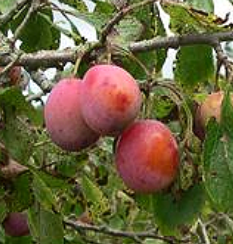

57. Victoria - Plum

Season : Mid season. Flowers April, Fruit August/Sept.
Pollination : Self Fertile. Group C
Victoria produces a lot of pollen and is a useful pollinator of other mid-season flowering plum varieties. The blossom is also more frost-resistant than that of many other plums.


Prunus domestica 'Victoria'
Victoria plums are medium sized, egg shaped and initially a golden yellow with a deep orange/red flush. As they ripen on the tree they take on a much darker, purple-ish colour - and if allowed to ripen fully are good to eat fresh.
However, it is more common to pick them a little earlier and use them for their excellent cooking properties.
Victoria really excels as a culinary plum. It cooks to a distinctive pink/orange puree which makes very good jam and a good-flavoured filling for pies and crumbles. The stone is semi-clinging, and fairly easy to remove from the flesh. The flavour has a good sweet/sharp balance, and there is often a note of almond in the background. (Plums and almonds are quite closely related).
Britain's best known plum
The story is that the plum was discovered in a garden in Alderton, Suffolk by a Mr Denyer, a nurseryman from Brixton in London who originally named it “Sharp’s Emperor”.
In 1837 when Queen Victoria was crowned, Denyer changed his plums name to “Denyer’s Victoria”.
Seven years later in 1844 it was introduced into Sweden where it became incredibly popular as a commercial variety, eventually finding its way back to our own orchards for reasons easily understood.




